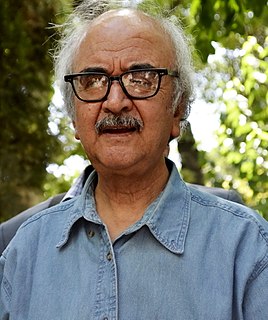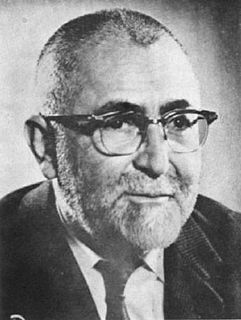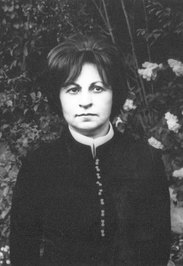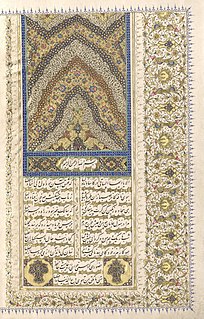Parvēz, Pērvaz or Parvīz, is a Persian male given name, mostly popular in Iran, Central Asia, South Asia and among Azeris. It is also a common surname.

Peter William Avery OBE was an eminent British scholar of Persian and a Fellow of King's College, Cambridge.

Mohammad-Reza Shafiei Kadkani is an Iranian writer, poet, literary critic, editor, and translator.

Parviz Natel Khanlari was an Iranian literary scholar, linguist, author, researcher, politician and professor at Tehran University.

Badiozzaman Forouzanfar or Badi'ozzamān Forūzānfar was a scholar of Persian literature, Iranian linguistics and culture, and an expert on Rumi and his works. He was a distinguished professor of literature at Tehran University.

The First Perso-Turkic War was fought during 588–589 between the Sasanian Empire and Hephthalite principalities and its lord the Göktürks. The conflict started with the invasion of the Sasanian Empire by the Turks and ended with a decisive Sasanian victory and the reconquest of lost lands.

Parviz Ghelichkhani is an Iranian-French retired football player and former captain of Iran national football team. He is now based in France, where he is the editor and publisher of a political magazine.
The Daylami language, also known as Daylamite, Deilami, Dailamite, or Deylami, is an extinct language that was one of the northwestern branch of the Iranian languages. It was spoken in northern Iran, specifically in the mountainous area in Gīlān, Mazandaran, and Ghazvin Provinces.
Iran Shenasi also spelled as "Iranshinasi" is an academic journal of Iranian studies. The founding editor-in-chief is Jalal Matini. The journal is published in Persian and covers Iranian history, Persian culture, and Persian literature. The majority of research libraries in the world that have a Middle Eastern or Iranian studies program are subscribers and it is considered one of the most authoritative journals on the culture of Iran and Persian literature.
Paran Parviz is a village in Malavi Rural District, in the Central District of Pol-e Dokhtar County, Lorestan Province, Iran. At the 2006 census, its population was 996, in 213 families.
Gur Parviz is a village in Donbaleh Rud-e Jonubi Rural District, Dehdez District, Izeh County, Khuzestan Province, Iran, located 293 miles south of the country's capital, Tehran. At the 2006 census, its population was 339, in 59 families.
Parviz Khanlu is a village in Garamduz Rural District, Garamduz District, Khoda Afarin County, East Azerbaijan Province, Iran. At the 2006 census, its population was 258, in 57 families.
Deh-e Parviz Sarani is a village in Qorqori Rural District, Qorqori District, Hirmand County, Sistan and Baluchestan Province, Iran. At the 2006 census, its population was 26, in 7 families.
Samak-e Ayyar is an ancient Persian romantic folklore story.
Shahriyarnameh is an epic poem in Persian which relates the stories of Shahriyar son of Borzu son of Sohrab son of Rostam. The stories take place in Hend, Send and Sarandip. According to Zabihollah Safa, the author of this epic is Othman Mokhtari, but Abbas Eqbal Ashtiani, Parviz Natel-Khanlari and Jalaluddin Homai reject this theory. The story has survived in three incomplete manuscripts which differs considerably, but all of them relate the same story. The first manuscripts seems to be from 18th century and contains 180 papers. In this manuscript, the author mentions his name as "Farrokhi". The second manuscript is kept in Tajikistan and contains the most comprehensive version of the poem. The third manuscript contains 32 papers and is kept in Britain.
Parviz Samedov was the National Hero of Azerbaijan, and the warrior of the First Nagorno-Karabakh War.
St. Louis School, Tehran was a French Catholic school established by the Lazarists in 1862 in Tehran, Iran.
She'r-e Nimaa'i is a school of Modernist poetry in Iran that is derived from the literary theory of Nima Yooshij, a contemporary Iranian poet. Nima Yoshij revolutionized the stagnant atmosphere of Iranian poetry with the influential poem Afsaneh, which was the manifesto of She'r-e Nimaa'i. He consciously challenged all the foundations and structures of ancient Persian poetry. The nature of Mazandaran, social criticism, and humor are just a few examples of the themes that Nima Yoshij used in his poems. She'r-e Nimaa'i was the source of inspiration and growth of many great modern Iranian poets, including Sohrab Sepehri, Forough Farrokhzad, Mehdi Akhavan-Sales and Fereydoun Moshiri.

Zahra Kia(Khanlari) was a researcher, author and translator. She translated Persian language and literature.

The Divān of Hafez is a collection of poems written by the Iranian poet Hafez. Most of these poems are in Persian, but there are some macaronic language poems and a completely Arabic ghazal. The most important part of this Divān is the ghazals. Poems in other forms such as qetʿe, qasida, mathnawi and rubaʿi are as well included in the Divān. There is no evidence that Hafez's lost poems might have constituted the majority of his poetic output, and in addition, Hafez was very famous during his lifetime. Therefore he cannot have been a prolific poet. The number of ghazals that are generally accepted is less than 500: 495 ghazals in Ghazvini and Ghani edition, 486 ghazals in Natel-Khanlari's second edition and 484 ghazals in the Sayeh edition.







